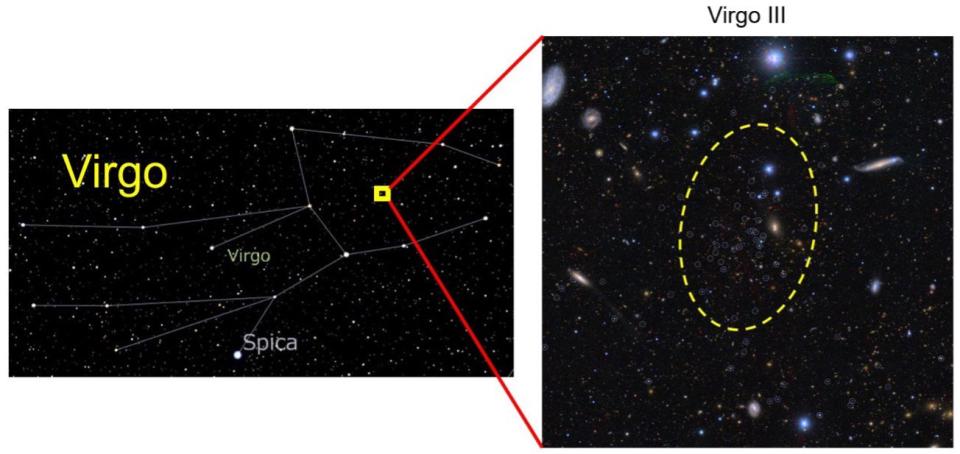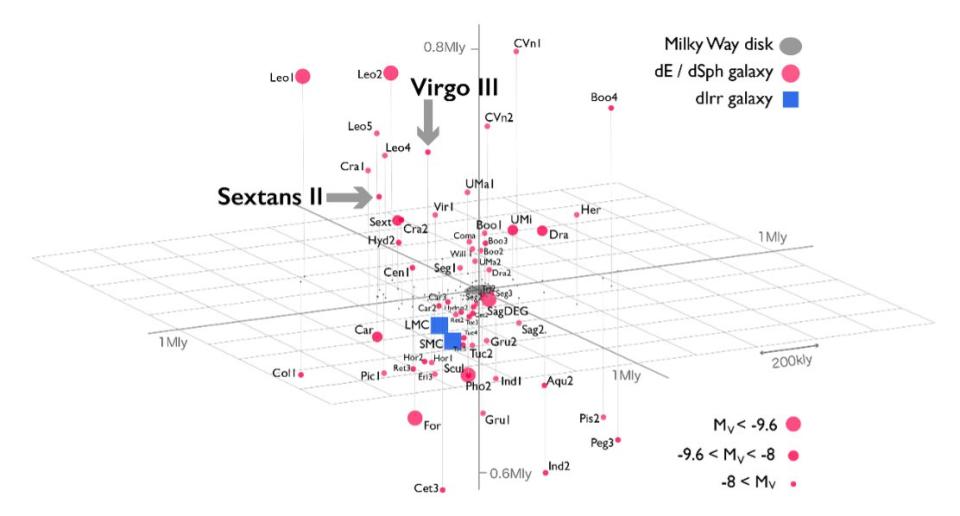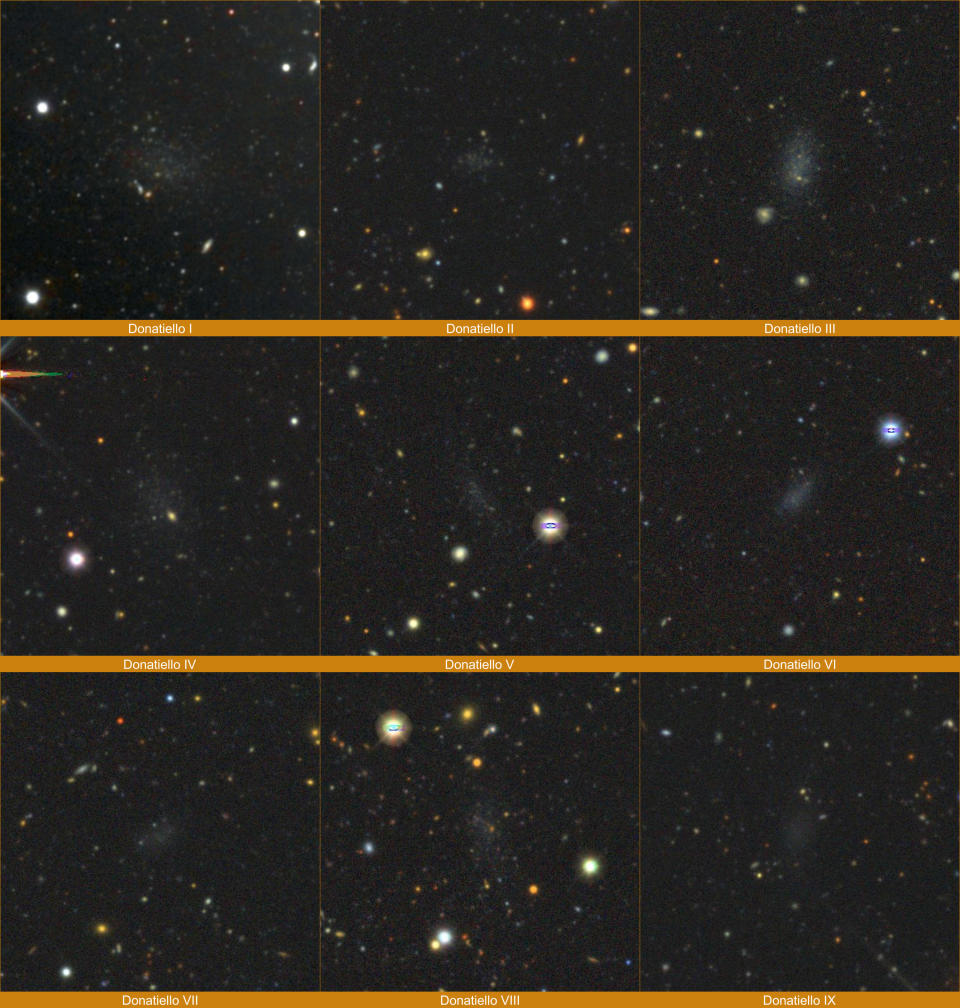Astronomers have discovered two new satellite galaxies of the Milky Way. The findings could help us better understand dark matter: the mysterious stuff that makes up about 85% of the matter in the universe, but remains essentially invisible to us.
The discoveries also bring scientists one step closer to solving a persistent problem with the Standard Model of cosmology, or the “lambda cold matter model,” also known as “ΛCDM, where the word ‘cold’ assumes that dark matter consists of particles moving slower than the speed of light.
The newly discovered small collections of stars have been named Sextans II and Virgo III. They join the 60 or so known dwarf galaxies that swarm our much larger home spiral galaxy at maximum distances of 1.4 million light-years. The best-known and largest of these dwarf galaxy satellites of the Milky Way are the Large Magellanic Cloud (LMC) and the Small Magellanic Cloud (SMC).
“How many satellite galaxies does the Milky Way have? This has been a major question for astronomers for decades,” team leader Masahi Chiba, a professor at Tohoku University, said in a statement.
Related: Amateur Astronomer Discovers 5 Fascinating New Galaxies — And Now They’re Named After Him
Many small dwarf galaxy satellites of the Milky Way remain undiscovered due to their distant and faint nature, but Chiba and his colleagues were determined to find these elusive objects. So they turned to the Subaru Telescope. This powerful ground-based telescope, located near the summit of Maunakea, Hawaii, is well-suited to hunting for dwarf galaxies, and the same team had previously used it to detect three new satellites of the Milky Way.

Help! Our dwarf galaxies have disappeared
Dark matter is an intractable cosmological problem because it interacts neither with light nor with the ordinary matter that makes up stars, planets, moons, and us. And, well, if it does interact with those things, the interactions are far too weak to notice.
That means dark matter could be made of particles that are currently undiscovered, though there are possible explanations that don’t require extensions of particle physics. For example, scientists have explored the idea that dark matter could be made of tiny primordial black holes left over from just after the Big Bang.
However, dark matter does interact with gravity, which can affect the motion and dynamics of light and everyday matter. This allowed scientists to infer the presence of dark matter and ultimately determine that large galaxies are surrounded by huge halos of this mysterious substance. These halos are believed to extend far beyond galactic disks and halos of visible matter.
The ΛCDM predicts that these dark matter halos played a major role in the evolution of galaxies. In the early universe, they formed gravitational wells into which the gas and dust that formed stars in galaxies was pulled. Eventually, these halos also collapsed, forming large galaxies like the Milky Way.


This model also suggests that there really should be hundreds of satellite galaxies around the Milky Way and other large galaxies. For example, simulations with ΛCDM predicts that our neighboring galaxy, Andromeda, should be surrounded by about 500 satellite galaxies. Yet astronomers have only seen 39 dwarf galaxies swirling around Andromeda.
For the Milky Way, some simulations based on the Standard Model of cosmology suggest that our galaxy should be orbited by about 220 dwarf galaxies, but scientists can’t figure out where they all are. The discovery of Sextans II and Virgo III helps redress that balance. However, the results from these findings could present cosmologists with the opposite problem they faced before.


Too few or too many dwarf galaxies?
While the number of identified galaxies is still significantly lower than the predicted 220 dwarf galaxies, the team behind this research took into account the fact that the Subaru cannot see the entire night sky above Earth.
They combined the distribution of dwarf galaxies that Subaru was able to see with its ‘footprint’ in the night sky to estimate the number of satellites should, In reality, they surround our galaxy. This led to the calculation that 500 galaxies surround the Milky Way — more than double the number predicted by simulations based on the ΛCDM system.
Have scientists gone from the “too few dwarf galaxies” problem to the “too many dwarf galaxies” problem?


Maybe not. Amateur astronomer Giuseppe Donatiello recently discovered five new satellite galaxies around the Sculptor galaxy, officially known as NGC 253.
When he and a team of astronomers looked at the distribution of satellite galaxies around the Sculptor galaxy, including three previously discovered by Donatiello himself, they found that the distribution of these galaxies, which are about 11.5 million light-years away from Earth, was uneven. In other words, the small galaxies appeared to have a “favored direction,” with more galaxies on one side of the Sculptor galaxy than on the other.
If there is also a preferred direction for dwarf galaxies around the Milky Way and the Subaru telescope happens to be looking in that direction, then the estimates based on Subaru’s observations would be incorrect.
Related Stories:
— Stephan’s Quintet: ‘It’s a Wonderful Life’ — and a beautiful photo from the James Webb Space Telescope!
— Scientists discover supercluster of galaxies with a mass of 26 trillion suns
—The James Webb Space Telescope may have discovered some of the very first stars
The team behind these findings on dwarf galaxies in the Milky Way now wants to further investigate the true number of satellite galaxies around us using another ground-based telescope.
“The next step is to use a more powerful telescope that captures a wider view of the sky,” Chiba concluded. “Next year, the Vera C. Rubin Observatory in Chile will be used to achieve that goal. I hope that many new satellite galaxies will be discovered.”
The team’s results were published June 8 in the Publications of the Astronomical Society of Japan.